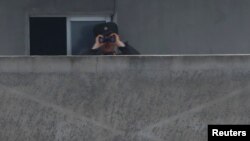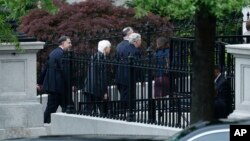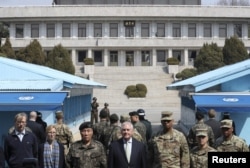Although Chinese Foreign Minister Wang Yi last month described the U.S. and North Korea as two accelerating trains that are set for a “head-on collision,” as of Wednesday, there are no indications that a U.S. military strike against Pyongyang is imminent.
President Donald Trump, however, has insisted he will no longer adhere to his predecessor’s policy of “strategic patience” toward North Korea. This suggests the administration is willing to consider the possibility of military action to prevent the North from developing a nuclear tipped intercontinental ballistic missile that could reach the U.S. mainland.
Amid this U.S.-North Korea standoff, it remains unclear whether China would respond with force to U.S. military action against the reclusive regime.
China unlikely to act
Ralph Cossa, president of the Pacific Forum CSIS organization in Honolulu, said he doubts China would take action.
“The Chinese aren’t going to war over a very ungrateful friend,” given that the North Koreans have “insulted and undermined Chinese national interests over the last couple of years.”
But some analysts say as long as any U.S. attack against North Korea aligns with China’s interests, Beijing will accept the U.S. action.
Cheng Xiaohe, an associate professor of international relations at Renmin University in Beijing, pointed out that the Chinese leadership has described Sino-North Korean relations several times as “normal state-to-state relations,” adding such a perception intimates that the 1961 alliance treaty, which guarantees Chinese military support for the North Korean regime, has become outmoded.
US must consult China
Any U.S. attack on North Korea, without China’s consent, would, however, reinvigorate the treaty, spurring North Korea’s last remaining major ally to safeguard the regime, Cheng added.
“It depends on how the U.S. strike is launched,” said Yun Sun, a senior associate with the East Asia Program at the Stimson Center. If the U.S. launches a pre-emptive strike against North Korea without any consultation with China, “China will very likely react militarily to such a strike.”
A recent editorial in the Chinese Communist Party newspaper, the Global Times, suggests that if Washington conducts a pre-emptive strike against North Korean nuclear facilities, Beijing would not militarily intervene. The editorial set forth a red line, however, stating that if South Korean and U.S. troops cross the inter-Korean border and try to topple the Kim Jong Un regime, Beijing would get involved militarily.
Scoop up the nukes
Bruce Bennett, a senior defense analyst with the Rand Corp., stressed that the line of demarcation between surgical strikes and a full-scale war is far from precise.
Bennett said if a war breaks out on the Korean peninsula, China’s deployment of its ground troops seems inevitable, but the country likely will focus on instituting a pro-China regime or seizing North Korea’s missile and nuclear sites, rather than a war with U.S.-South Korea joint military forces.
“Look, a pre-emptive strike, if we hit one airfield, we’re not going to do the job that needs to be done,” he said. He pointed out that other than the widely known nuclear facilities, North Korea is believed to have numerous fortified underground sites across the country.
“We have to hit dozens of targets,” Bennett said. “If we hit dozens of targets, it’s going to take days, if not weeks, of strikes that make a difference against North Korea. That’s a big war.”
On Tuesday, a U.S. submarine designed to carry 150 Tomahawk cruise missiles entered a South Korean port. The USS Carl Vinson aircraft carrier group also is heading to the region and conducting naval exercises with Japan and South Korea. Also this week, the U.S. began moving part of the THAAD missile defense system to its deployment site 250 kilometers south of Seoul.
VOA’s Jenny Lee contributed to this report.









![[VOA 뉴스 투데이] 2024년 11월 16일](https://gdb.voanews.com/61f850ed-d018-4ad3-aeea-cc73141b1a7c_w33_r1.jpg)

